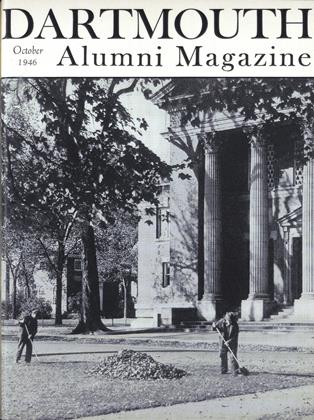by Bradley M.Patten '11, Blakiston, 1946, 776 pages. $7.00
The second edition of Bradley Patten's "Embryology of the Pig" is now fifteen years old. The decision was made long ago to follow it with this "Human Embryology," for it is obviously better from the publisher's and the teacher's standpoint to have Man in the center of the stage, even if the anatomically interesting differences in development between pigs and people are very slight. The first six of the nineteen chapters bear a strong resemblance to the Pig book, and most of the old illustrations are used again, but there are about 700 fact-packed pages of text and 1366 illustrations, an amazing number of them done by the author's own gifted hand. There are a series of very welcome figures of the young human embryos discovered within the last fifteen years. The second half of the book very richly portrays the details of histo-differentiation of human organs and organ systems.
The encyclopaedic scope and the rigid exclusion of non-mammalian, and very largely also of non-human material, makes the book better adapted for a medical than for a premedical course, but a real effort has obviously been made to ease the student gently into the intricacies of each chapter. The many ingenious diagrams and the friendly, almost chatty style of the text, will be appreciated.
Very little pruning can be done in this book without sacrifice of useful material. One regrets the entire absence of reference to the field of experimental embryology. The chapter on the nervous system is expertly but formidably condensed, there being less space given to it than to the circulatory system (Patten's research field). Nevertheless, this is an elegant and an exceedingly useful job, taking its place at once as one of the best texts in the field. It is dedicated to the author's father, William Patten, the man who lives in the memories of most Dartmouth alumni as the director of the famous course in Evolution. Quotations from the writings of William Patten, and some of his drawings of facial development in human embryos, are reprinted in the text. And as usual, Bradley Patten says the manuscript would never have been completed without the encouragement and direct help of his wife, who, one gathers, is the only one who can read his handwriting. Embryology owes a very large debt to the whole family.
Two recent publications in the Dartmouth College Library series are a longpoem, Not One Atoll, by Dilys Bennett Laing, wife of Alexander Laing '25, and The Odyssey and the HumanSoul by Paul C. Kintzing Jr. '46. Written in a study in Baker Library, Not One Atoll was read by Mrs. Laing at the 1946 exercises of the Tufts College chapter of Phi Beta Kappa. It excited unusual interest during its use in several classroom discussions at Dartmouth and its publication in the Library series followed. The analysis of the Odyssey in terms of the journey of the human soul toward perfection was written by Mr. Kintzing who was recently discharged from the Navy and who is studying for the Episcopal priesthood.
 View Full Issue
View Full Issue
More From This Issue
-
 Sports
SportsWith Big Green Teams
October 1946 By Francis E. Merrill '26 -
 Class Notes
Class Notes1917
October 1946 By MOTT D. BROWN, DONALD BROOKS, SUMNER B. EMERSON -
 Article
ArticleOPERATION CROSSROADS
October 1946 By WILLIAM J. MITCHEL JR. '42 -
 Article
ArticleThe Coming "Boom and Bust"
October 1946 By BRUCE W. KNIGHT -
 Article
ArticleCan We Achieve Economic Stability?
October 1946 By JAMES F. CUSICK, -
 Class Notes
Class Notes1918
October 1946 By ERNEST 11. EARLEY, DONALD L. BARR
W. W. Ballard '28
Books
-
 Books
Books"The Technology of New York State Timbers"
APRIL, 1927 -
 Books
BooksTHE FLEET TODAY
February 1941 By A. L. DEMAREE. -
 Books
BooksHORTON HATCHES THE EGG
December 1940 By Alexander Laing '25 -
 Books
BooksNINE SATURDAYS MAKE A YEAR.
OCTOBER 1962 By Cliff Jordan ’45 -
 Books
BooksSAMUEL BECKETT: POET AND CRITIC.
FEBRUARY 1971 By J. D. O'HARA '53 -
 Books
BooksNotes on a realist among the Cassandras and one microcosmic answer to a macrocosmic question
NOV. 1977 By R.H.R.



